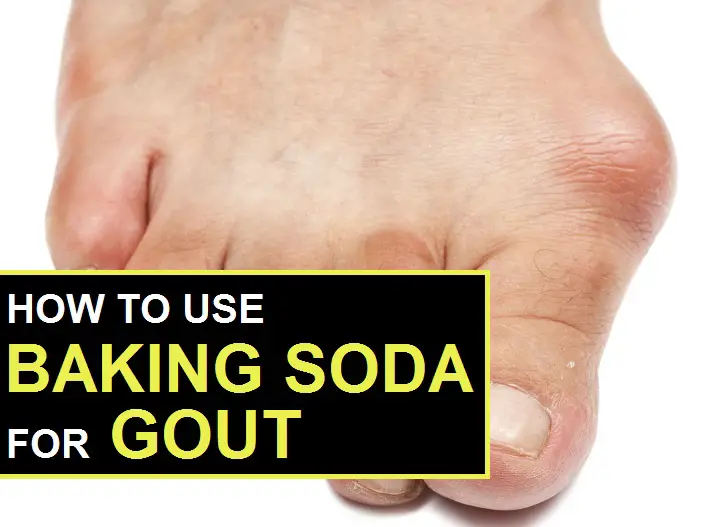
Important: This article is for informational purposes only. Please read our full disclaimer for more details.
Gouts are caused due to a high increase of acid levels in the body. You will feel acute pain, swelling, intense tenderness, and inflammation at the joints if you are suffering from gout.(1)
If you are suffering from gout then you must know that you have high uric acid content in your body and it is unable to flush it out from your system. The uric acid forms crystals in the fluids around the bone joints. It leads to inflammation, swelling and pain. A simple home remedy is using baking soda. It is alkaline and helps in reducing the problem.
Baking Soda for Gout Does it Work?
- Baking soda is extremely helpful in addressing your gout problem. It is alkaline in nature and reduces the ph content in the blood. It prevents the formation of crystals in the blood.(2)
- It helps in the solubility of the uric acid crystals. In this way it can be easily flushed out by the kidneys and restore the body balances back to normal. Too much acidity in the body adversely affects our health.
- The anti-inflammatory properties in baking soda help to ease the gout pain and also reduce the pain in the joints. Baking soda is also useful in checking the growth of kidney stones. It also helps in reducing the size of the stone.
Here are some methods of consuming baking soda if you are suffering from gout.
How to Use Baking Soda for Gout?
1. Lemon Juice and Baking Soda for Gout
Ingredients needed:
Procedure to be Followed:
- Pour the baking soda and lemon juice into the glass of water
- Stir it well till it dissolves into the glass of water.
- Drink this water immediately for quick relief.
- Repeat this method at least 2 to 3 times a day to get the best result from this remedy.
Benefit: The Vitamin C present in lemon helps to excrete the uric acid from the body.
2. Apple Cider Vinegar and Baking Soda for Gout
Ingredients needed:
- 1 tablespoon of baking soda.(4)
- 1 tablespoon of apple cider vinegar.
- I glass of water
Procedure to be Followed:
- Pour the baking soda and apple cider vinegar into the glass of water
- Stir it well till it dissolves into the glass of water.
- Drink this water immediately for quick relief.
- Repeat this method at least 4 times a day to get the best result from this remedy.
- It is best to space out your dinks evenly throughout the day.
Benefit: ACV contains a lot of potassium that removes toxins and excess water from the body. The iron oxide and toxins reduce te build up of toxins.
3. Water and Baking Soda for Gout
Ingredients needed:
- 1 tablespoon of baking soda.(5)
- I glass of water
Procedure to be Followed:
- Pour the baking soda into the glass of water
- Stir it well till it dissolves into the glass of water.
- Drink this water immediately for quick relief.
- Repeat this method at least 4 times a day to get the best result from this remedy.
- It is best to space out your dinks evenly throughout the day.
- This method is easy to follow and works instantly.
Conclude:
These are some of the methods in which you can use baking soda to get rid of your gout. It is however very advisable to consult your doctor before you completely depend on the home remedy cures the gout. The methods may interact with any kind of medication that you are already taking.
You should not freely intake baking soda in large quantities as it will lead to nausea, blood pressure rise, slow breathing, restlessness, hypertension etc. It is necessary that you reduce your stress and try and meditate and do some deep breathing exercises. Improve your daily diet by consuming a lot of fresh fruits, vegetables, foods rich in vitamin C and grains.
Best Gout Relief Creams
| Top Picks | Check Price |
|---|---|
| Best Overall-Vita Sciences Effective Gout Relief Cream | Buy on Amazon |
| Runner Up-Gout and You Therapeutic Gout Relief Cream | Buy on Amazon |
| Popular With Consumers-Nextrino Gout Relief Cream | Buy on Amazon |
You Might Also Like:
- How to Use Baking Soda for Blackheads?
- How to Use Baking Soda for Dark Circles Under Eyes?
- How to Lighten Dark Elbows with Baking Soda?
- How to Whiten Dark Neck with Baking Soda
- How to Lighten Dark Underarms With Baking Soda?
- How To Whiten Your Teeth With Baking Soda – 7 Best Ways
- Is It Safe to Use Baking Soda on Your Hair?
- How to Use Baking Soda to Reduce Bloating?
- Top 6 Surprising Side Effects of Baking Soda
- Does Baking Soda Help Clogged Pores?
- Does Baking Soda and Shampoo Lighten Hair?
- Can I Add Baking Soda to My Shampoo?
- 14 Surprising Beauty Benefits of Baking Soda You Must Know!
- How To Take Cherry Juice For Gout
- How Much Water To Drink To Flush Out Soda
- Is Celery Seed Good for Gout?
Image:- 1
















